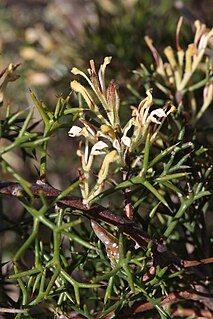
Hakea myrtoides, commonly known as myrtle hakea, is a shrub endemic to the woodlands of the Darling Range near Perth in Western Australia.

Hakea scoparia is a species of flowering plant in the family Proteaceae and is endemic to the south-west of Western Australia where it grows in shrubland. It is a shrub with ascending branches, terete leaves and clusters of cream to pinkish flowers in leaf axils from June to September.

Hakea corymbosa, commonly known as the cauliflower hakea is a plant of the family Proteaceae which is endemic to the south-west of Western Australia. An attractive extremely prickly bush with sweetly scented yellowish flowers. The nectar rich blooms and dense form provides a good habitat for wildlife.

Hakea erinacea, commonly known as hedgehog or porcupine hakea, is a shrub in the family Proteaceae endemic to south-west Western Australia.

Hakea undulata, commonly known as wavy-leaved hakea, is a flowering plant in the family Proteaceae and is endemic to the south-west of Western Australia. It has stiff wavy leaves and fragrant cream-white flowers from mid-winter to October.

Hakea verrucosa is a flowering plant in the family Proteaceae that is endemic to south-west Western Australia. It has large white, deep pink or red pendulous flowers with stiff needle-shaped leaves.

Hakea ambigua is a shrub in the family Proteaceae. In favourable conditions may grow into an attractive weeping shrub with creamy white flowers. Only found in the Stirling Ranges of southern Western Australia.

Hakea brownii commonly known fan-leaf hakea is a shrub in the family Proteaceae native to an area in the Wheatbelt region of Western Australia. This species shares a common name with Hakea baxteri due to its distinctive leaves.

Hakea costata, commonly known as the ribbed hakea, is a shrub in the family Proteaceae native to Western Australia. A multi-stemmed small shrub producing attractive pink or white brush-like blooms rich in nectar from July to October.

Hakea gilbertii is a shrub in the family Proteacea and is endemic to an area in the Wheatbelt region of Western Australia. It is an upright, prickly shrub with greyish needle-shaped leaves and clusters of fragrant flowers from late winter to spring.

Hakea horrida is a shrub in the family Proteacea and is endemic to an area in the Wheatbelt, Great Southern and Goldfields-Esperance regions of Western Australia. It is a small dense shrub, extremely prickly with large creamy white scented flowers.

Hakea varia, commonly known as the variable-leaved hakea, is a shrub of the family Proteacea and endemic to Wheatbelt, South West, Great Southern and Goldfields-Esperance regions of Western Australia. It is a dense prickly shrub with creamy-white or yellow flowers and variable shaped leaves.

Hakea loranthifolia is a shrub of the family Proteaceae and is endemic to Western Australia. It has an open growth habit, stiff egg-shaped leaves with longitudinal veins, smooth grey bark and white flowers from July to September.

Hakea multilineata, commonly known as grass-leaved hakea, is a shrub in the family Proteaceae. It is endemic to an area in the Wheatbelt and Goldfields-Esperance regions of Western Australia. It has pink to red long racemes in upper leaf axils and leathery linear leaves.

Hakea preissii, commonly known as the needle tree, needle bush and Christmas hakea, is a shrub or tree of the genus Hakea native to Western Australia. The Noongar name for the plant is Tanjinn.
Hakea pritzelii is a flowering shrub in the family Proteaceae and is endemic to a few small areas in the Great Southern region of Western Australia. It has rigid, pale green leaves and scented red-purple flowers.

Hakea smilacifolia is a shrub in the family Proteacea. It has sweetly scented flowers, stiff leathery leaves and is endemic to an area in the Mid West, western Wheatbelt and the Goldfields-Esperance regions of Western Australia.

Hakea strumosa is a shrub in the family Proteacea endemic to an area in the Wheatbelt, Great Southern and the Goldfields-Esperance regions of Western Australia. A dense, very prickly shrub with a profusion of small, deep pink or red flowers in spring.

Hakea subsulcata is a shrub in the family Proteacea and endemic to an area in the Wheatbelt, Great Southern and the Goldfields-Esperance regions of Western Australia. It is an upright, broom-like shrub with needle-shaped leaves and purple-pink flowers from winter to early spring.
Olearia lehmanniana is a species of flowering plant in the family Asteraceae and is endemic to inland areas of the south-west of Western Australia. It is a shrub with scattered elliptic or linear leaves that are densely hairy on the lower surface, and pale mauve, daisy-like inflorescences.



















